Rui Han
From Gallery to Wrist: Realistic 3D Bracelet Insertion in Videos
Jul 27, 2025Abstract:Inserting 3D objects into videos is a longstanding challenge in computer graphics with applications in augmented reality, virtual try-on, and video composition. Achieving both temporal consistency, or realistic lighting remains difficult, particularly in dynamic scenarios with complex object motion, perspective changes, and varying illumination. While 2D diffusion models have shown promise for producing photorealistic edits, they often struggle with maintaining temporal coherence across frames. Conversely, traditional 3D rendering methods excel in spatial and temporal consistency but fall short in achieving photorealistic lighting. In this work, we propose a hybrid object insertion pipeline that combines the strengths of both paradigms. Specifically, we focus on inserting bracelets into dynamic wrist scenes, leveraging the high temporal consistency of 3D Gaussian Splatting (3DGS) for initial rendering and refining the results using a 2D diffusion-based enhancement model to ensure realistic lighting interactions. Our method introduces a shading-driven pipeline that separates intrinsic object properties (albedo, shading, reflectance) and refines both shading and sRGB images for photorealism. To maintain temporal coherence, we optimize the 3DGS model with multi-frame weighted adjustments. This is the first approach to synergize 3D rendering and 2D diffusion for video object insertion, offering a robust solution for realistic and consistent video editing. Project Page: https://cjeen.github.io/BraceletPaper/
Shining Yourself: High-Fidelity Ornaments Virtual Try-on with Diffusion Model
Mar 20, 2025Abstract:While virtual try-on for clothes and shoes with diffusion models has gained attraction, virtual try-on for ornaments, such as bracelets, rings, earrings, and necklaces, remains largely unexplored. Due to the intricate tiny patterns and repeated geometric sub-structures in most ornaments, it is much more difficult to guarantee identity and appearance consistency under large pose and scale variances between ornaments and models. This paper proposes the task of virtual try-on for ornaments and presents a method to improve the geometric and appearance preservation of ornament virtual try-ons. Specifically, we estimate an accurate wearing mask to improve the alignments between ornaments and models in an iterative scheme alongside the denoising process. To preserve structure details, we further regularize attention layers to map the reference ornament mask to the wearing mask in an implicit way. Experimental results demonstrate that our method successfully wears ornaments from reference images onto target models, handling substantial differences in scale and pose while preserving identity and achieving realistic visual effects.
Let Curves Speak: A Continuous Glucose Monitor based Large Sensor Foundation Model for Diabetes Management
Dec 12, 2024



Abstract:While previous studies of AI in diabetes management focus on long-term risk, research on near-future glucose prediction remains limited but important as it enables timely diabetes self-management. Integrating AI with continuous glucose monitoring (CGM) holds promise for near-future glucose prediction. However, existing models have limitations in capturing patterns of blood glucose fluctuations and demonstrate poor generalizability. A robust approach is needed to leverage massive CGM data for near-future glucose prediction. We propose large sensor models (LSMs) to capture knowledge in CGM data by modeling patients as sequences of glucose. CGM-LSM is pretrained on 15.96 million glucose records from 592 diabetes patients for near-future glucose prediction. We evaluated CGM-LSM against state-of-the-art methods using the OhioT1DM dataset across various metrics, prediction horizons, and unseen patients. Additionally, we assessed its generalizability across factors like diabetes type, age, gender, and hour of day. CGM-LSM achieved exceptional performance, with an rMSE of 29.81 mg/dL for type 1 diabetes patients and 23.49 mg/dL for type 2 diabetes patients in a two-hour prediction horizon. For the OhioT1DM dataset, CGM-LSM achieved a one-hour rMSE of 15.64 mg/dL, halving the previous best of 31.97 mg/dL. Robustness analyses revealed consistent performance not only for unseen patients and future periods, but also across diabetes type, age, and gender. The model demonstrated adaptability to different hours of day, maintaining accuracy across periods of various activity intensity levels. CGM-LSM represents a transformative step in diabetes management by leveraging pretraining to uncover latent glucose generation patterns in sensor data. Our findings also underscore the broader potential of LSMs to drive innovation across domains involving complex sensor data.
RTMPose: Real-Time Multi-Person Pose Estimation based on MMPose
Mar 13, 2023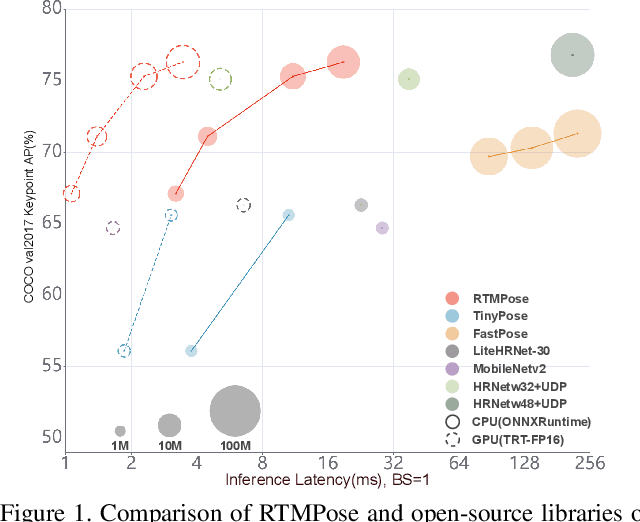
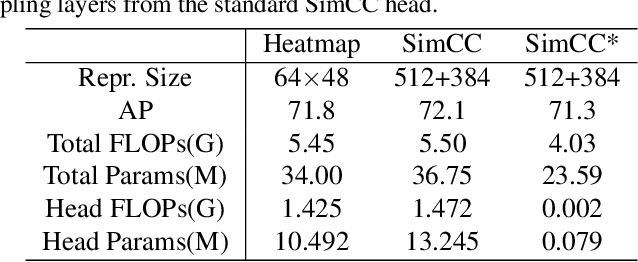

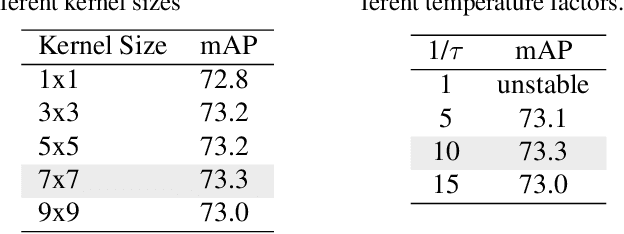
Abstract:Recent studies on 2D pose estimation have achieved excellent performance on public benchmarks, yet its application in the industrial community still suffers from heavy model parameters and high latency. In order to bridge this gap, we empirically explore key factors in pose estimation including paradigm, model architecture, training strategy, and deployment, and present a high-performance real-time multi-person pose estimation framework, RTMPose, based on MMPose. Our RTMPose-m achieves 75.8% AP on COCO with 90+ FPS on an Intel i7-11700 CPU and 430+ FPS on an NVIDIA GTX 1660 Ti GPU, and RTMPose-l achieves 67.0% AP on COCO-WholeBody with 130+ FPS. To further evaluate RTMPose's capability in critical real-time applications, we also report the performance after deploying on the mobile device. Our RTMPose-s achieves 72.2% AP on COCO with 70+ FPS on a Snapdragon 865 chip, outperforming existing open-source libraries. Code and models are released at https://github.com/open-mmlab/mmpose/tree/1.x/projects/rtmpose.
FedKNOW: Federated Continual Learning with Signature Task Knowledge Integration at Edge
Dec 04, 2022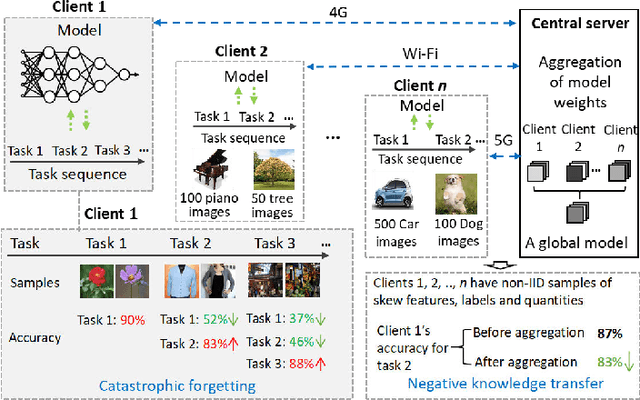
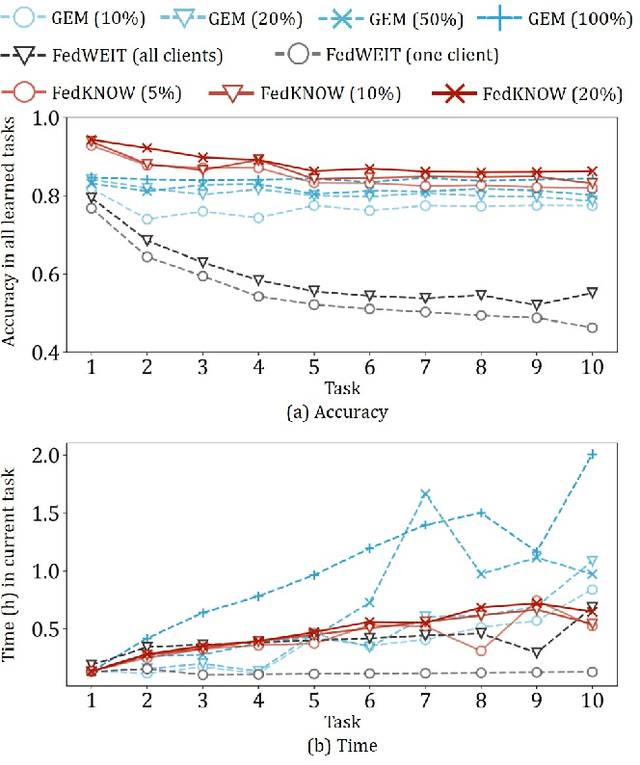

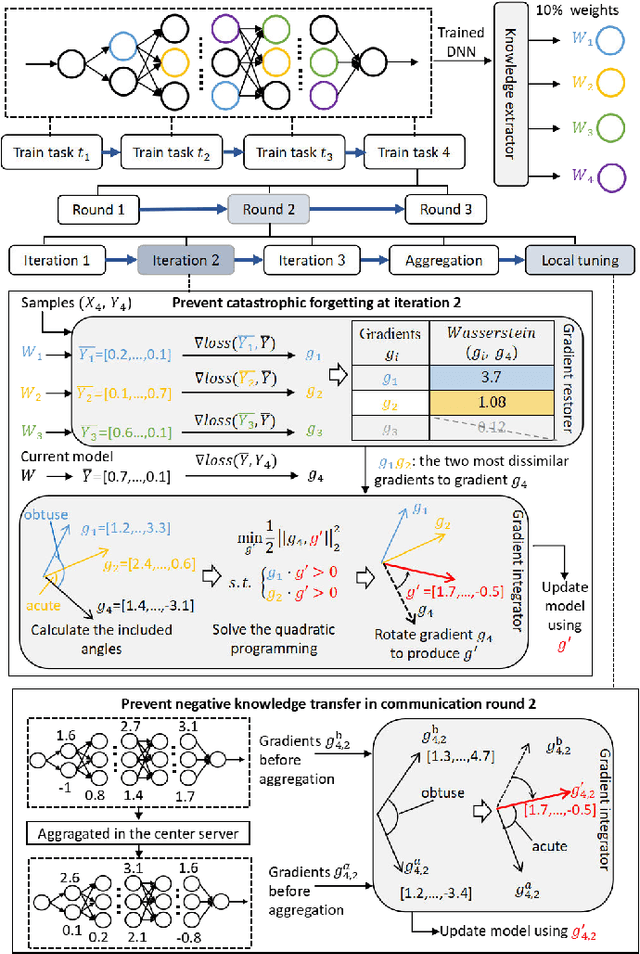
Abstract:Deep Neural Networks (DNNs) have been ubiquitously adopted in internet of things and are becoming an integral of our daily life. When tackling the evolving learning tasks in real world, such as classifying different types of objects, DNNs face the challenge to continually retrain themselves according to the tasks on different edge devices. Federated continual learning is a promising technique that offers partial solutions but yet to overcome the following difficulties: the significant accuracy loss due to the limited on-device processing, the negative knowledge transfer caused by the limited communication of non-IID data, and the limited scalability on the tasks and edge devices. In this paper, we propose FedKNOW, an accurate and scalable federated continual learning framework, via a novel concept of signature task knowledge. FedKNOW is a client side solution that continuously extracts and integrates the knowledge of signature tasks which are highly influenced by the current task. Each client of FedKNOW is composed of a knowledge extractor, a gradient restorer and, most importantly, a gradient integrator. Upon training for a new task, the gradient integrator ensures the prevention of catastrophic forgetting and mitigation of negative knowledge transfer by effectively combining signature tasks identified from the past local tasks and other clients' current tasks through the global model. We implement FedKNOW in PyTorch and extensively evaluate it against state-of-the-art techniques using popular federated continual learning benchmarks. Extensive evaluation results on heterogeneous edge devices show that FedKNOW improves model accuracy by 63.24% without increasing model training time, reduces communication cost by 34.28%, and achieves more improvements under difficult scenarios such as large numbers of tasks or clients, and training different complex networks.
Atrial Fibrillation Detection Using Weight-Pruned, Log-Quantised Convolutional Neural Networks
Jun 14, 2022


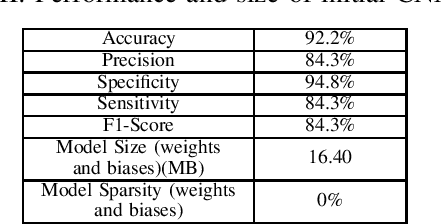
Abstract:Deep neural networks (DNN) are a promising tool in medical applications. However, the implementation of complex DNNs on battery-powered devices is challenging due to high energy costs for communication. In this work, a convolutional neural network model is developed for detecting atrial fibrillation from electrocardiogram (ECG) signals. The model demonstrates high performance despite being trained on limited, variable-length input data. Weight pruning and logarithmic quantisation are combined to introduce sparsity and reduce model size, which can be exploited for reduced data movement and lower computational complexity. The final model achieved a 91.1% model compression ratio while maintaining high model accuracy of 91.7% and less than 1% loss.
LegoDNN: Block-grained Scaling of Deep Neural Networks for Mobile Vision
Dec 18, 2021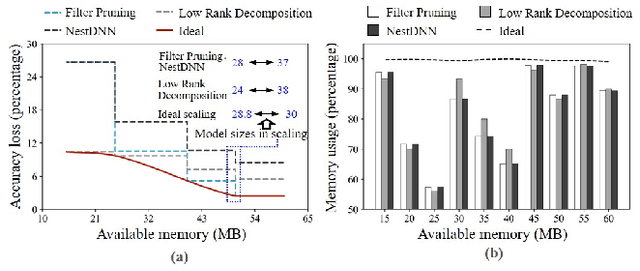
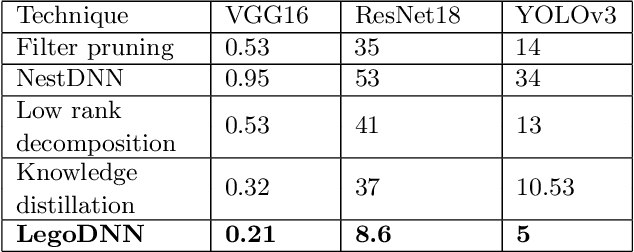
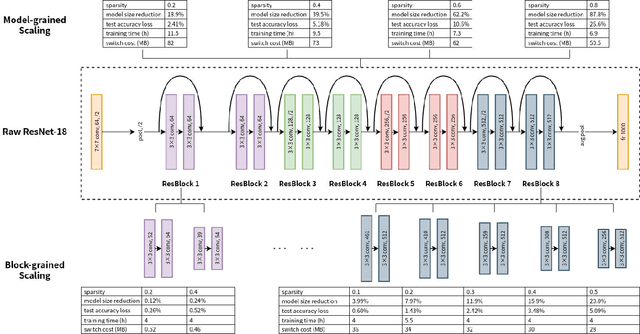

Abstract:Deep neural networks (DNNs) have become ubiquitous techniques in mobile and embedded systems for applications such as image/object recognition and classification. The trend of executing multiple DNNs simultaneously exacerbate the existing limitations of meeting stringent latency/accuracy requirements on resource constrained mobile devices. The prior art sheds light on exploring the accuracy-resource tradeoff by scaling the model sizes in accordance to resource dynamics. However, such model scaling approaches face to imminent challenges: (i) large space exploration of model sizes, and (ii) prohibitively long training time for different model combinations. In this paper, we present LegoDNN, a lightweight, block-grained scaling solution for running multi-DNN workloads in mobile vision systems. LegoDNN guarantees short model training times by only extracting and training a small number of common blocks (e.g. 5 in VGG and 8 in ResNet) in a DNN. At run-time, LegoDNN optimally combines the descendant models of these blocks to maximize accuracy under specific resources and latency constraints, while reducing switching overhead via smart block-level scaling of the DNN. We implement LegoDNN in TensorFlow Lite and extensively evaluate it against state-of-the-art techniques (FLOP scaling, knowledge distillation and model compression) using a set of 12 popular DNN models. Evaluation results show that LegoDNN provides 1,296x to 279,936x more options in model sizes without increasing training time, thus achieving as much as 31.74% improvement in inference accuracy and 71.07% reduction in scaling energy consumptions.
* 13 pages, 15 figures
Enhancing Robustness of On-line Learning Models on Highly Noisy Data
Mar 19, 2021


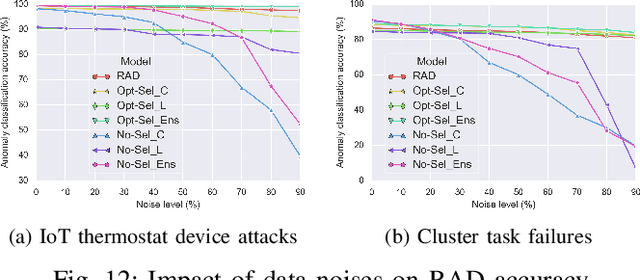
Abstract:Classification algorithms have been widely adopted to detect anomalies for various systems, e.g., IoT, cloud and face recognition, under the common assumption that the data source is clean, i.e., features and labels are correctly set. However, data collected from the wild can be unreliable due to careless annotations or malicious data transformation for incorrect anomaly detection. In this paper, we extend a two-layer on-line data selection framework: Robust Anomaly Detector (RAD) with a newly designed ensemble prediction where both layers contribute to the final anomaly detection decision. To adapt to the on-line nature of anomaly detection, we consider additional features of conflicting opinions of classifiers, repetitive cleaning, and oracle knowledge. We on-line learn from incoming data streams and continuously cleanse the data, so as to adapt to the increasing learning capacity from the larger accumulated data set. Moreover, we explore the concept of oracle learning that provides additional information of true labels for difficult data points. We specifically focus on three use cases, (i) detecting 10 classes of IoT attacks, (ii) predicting 4 classes of task failures of big data jobs, and (iii) recognising 100 celebrities faces. Our evaluation results show that RAD can robustly improve the accuracy of anomaly detection, to reach up to 98.95% for IoT device attacks (i.e., +7%), up to 85.03% for cloud task failures (i.e., +14%) under 40% label noise, and for its extension, it can reach up to 77.51% for face recognition (i.e., +39%) under 30% label noise. The proposed RAD and its extensions are general and can be applied to different anomaly detection algorithms.
ExpertNet: Adversarial Learning and Recovery Against Noisy Labels
Jul 13, 2020
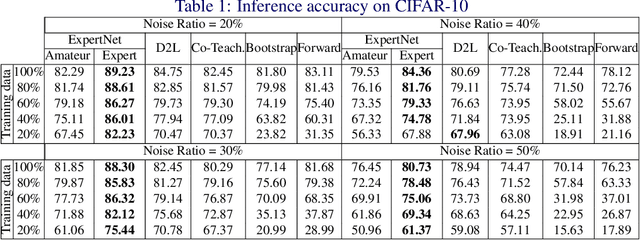
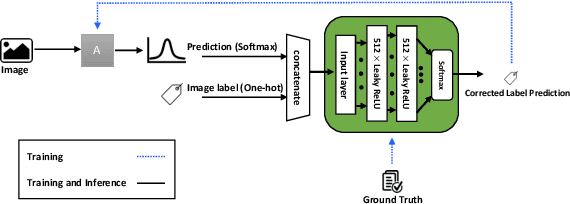
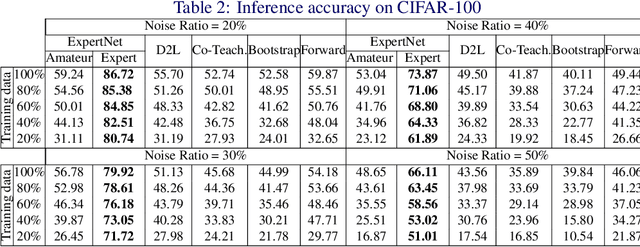
Abstract:Today's available datasets in the wild, e.g., from social media and open platforms, present tremendous opportunities and challenges for deep learning, as there is a significant portion of tagged images, but often with noisy, i.e. erroneous, labels. Recent studies improve the robustness of deep models against noisy labels without the knowledge of true labels. In this paper, we advocate to derive a stronger classifier which proactively makes use of the noisy labels in addition to the original images - turning noisy labels into learning features. To such an end, we propose a novel framework, ExpertNet, composed of Amateur and Expert, which iteratively learn from each other. Amateur is a regular image classifier trained by the feedback of Expert, which imitates how human experts would correct the predicted labels from Amateur using the noise pattern learnt from the knowledge of both the noisy and ground truth labels. The trained Amateur and Expert proactively leverage the images and their noisy labels to infer image classes. Our empirical evaluations on noisy versions of CIFAR-10, CIFAR-100 and real-world data of Clothing1M show that the proposed model can achieve robust classification against a wide range of noise ratios and with as little as 20-50% training data, compared to state-of-the-art deep models that solely focus on distilling the impact of noisy labels.
RAD: On-line Anomaly Detection for Highly Unreliable Data
Nov 11, 2019
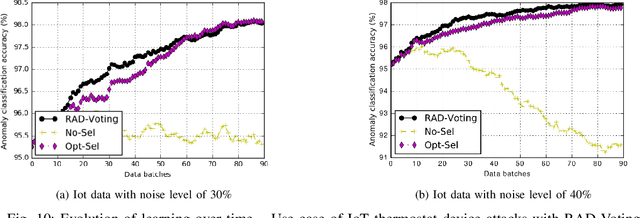
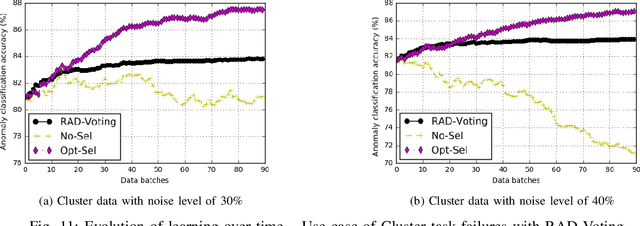
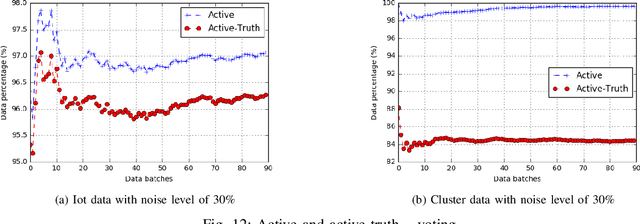
Abstract:Classification algorithms have been widely adopted to detect anomalies for various systems, e.g., IoT, cloud and face recognition, under the common assumption that the data source is clean, i.e., features and labels are correctly set. However, data collected from the wild can be unreliable due to careless annotations or malicious data transformation for incorrect anomaly detection. In this paper, we present a two-layer on-line learning framework for robust anomaly detection (RAD) in the presence of unreliable anomaly labels, where the first layer is to filter out the suspicious data, and the second layer detects the anomaly patterns from the remaining data. To adapt to the on-line nature of anomaly detection, we extend RAD with additional features of repetitively cleaning, conflicting opinions of classifiers, and oracle knowledge. We on-line learn from the incoming data streams and continuously cleanse the data, so as to adapt to the increasing learning capacity from the larger accumulated data set. Moreover, we explore the concept of oracle learning that provides additional information of true labels for difficult data points. We specifically focus on three use cases, (i) detecting 10 classes of IoT attacks, (ii) predicting 4 classes of task failures of big data jobs, (iii) recognising 20 celebrities faces. Our evaluation results show that RAD can robustly improve the accuracy of anomaly detection, to reach up to 98% for IoT device attacks (i.e., +11%), up to 84% for cloud task failures (i.e., +20%) under 40% noise, and up to 74% for face recognition (i.e., +28%) under 30% noisy labels. The proposed RAD is general and can be applied to different anomaly detection algorithms.
 Add to Chrome
Add to Chrome Add to Firefox
Add to Firefox Add to Edge
Add to Edge